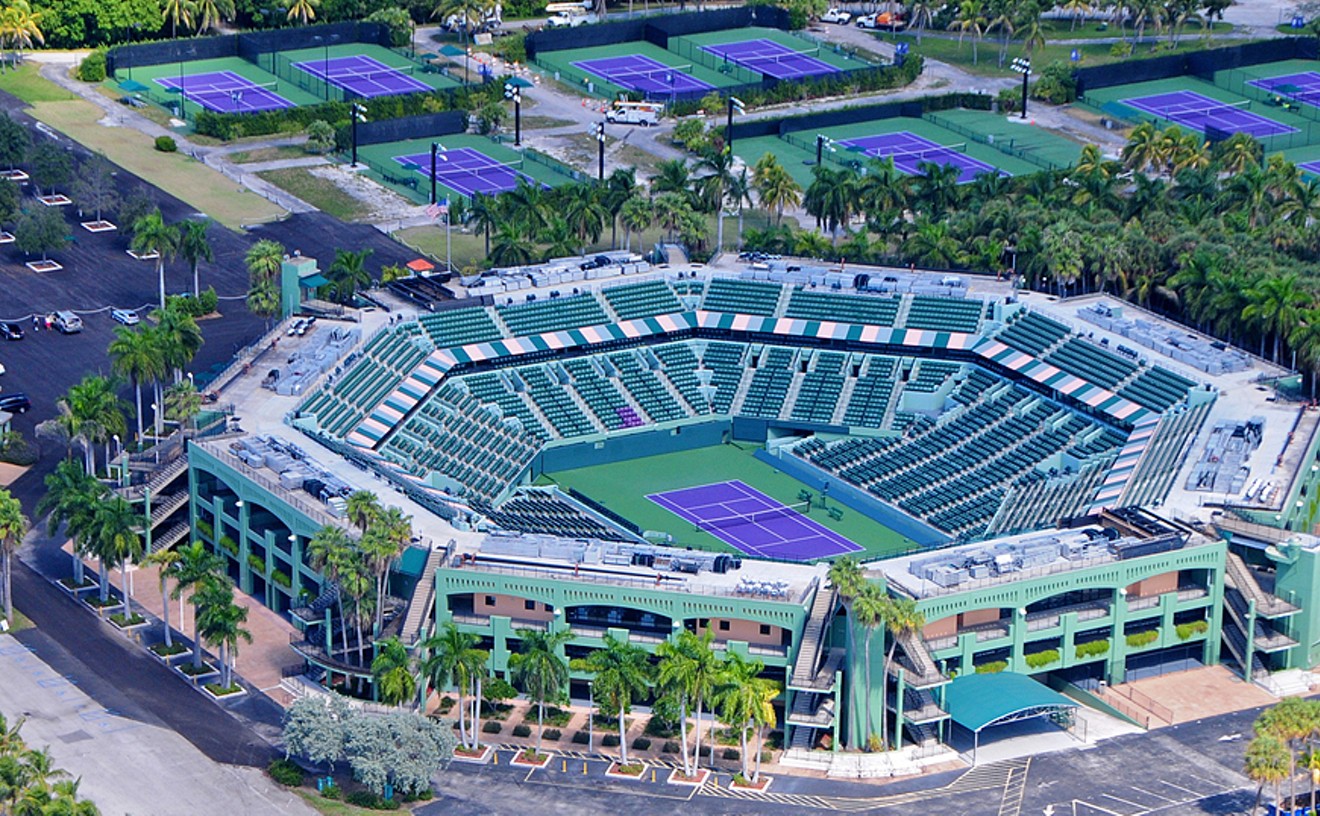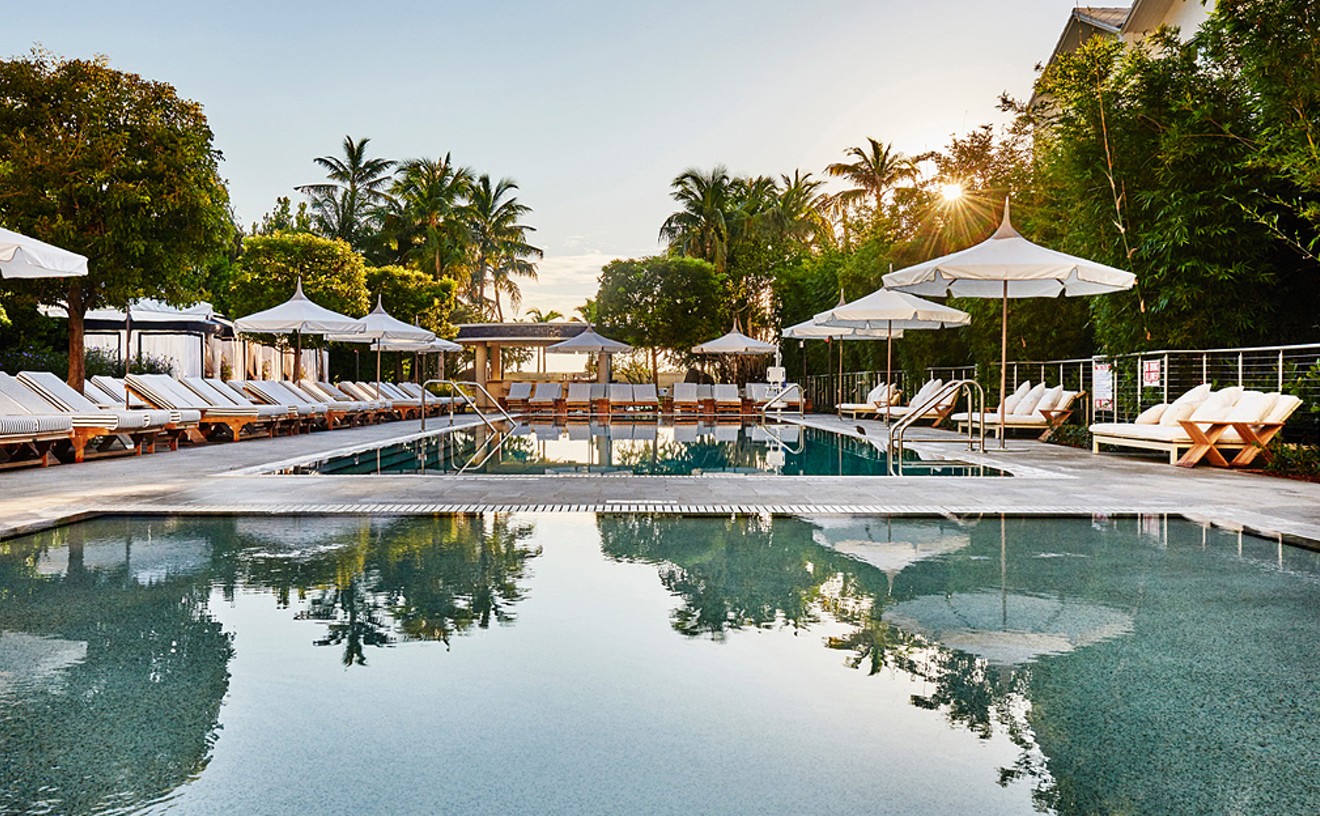The Underline is an ambitious plan to convert the path beneath the Metrorail into a ten-mile linear urban trail, designed by top architects and urban landscapers to be Miami's answer to New York's now-iconic High Line. But anyone who has run on the curvy trail today knows it's already great. The Metrorail's tall infrastructure casts a cooling shadow on the trail, and whizzing trains send a steady breeze down while your feet hit the pavement. Sea grape leaves and rock doves line the path beside you. And for now — before the starchitects and the glowing national media move in — it's a relatively seldom-used trail, making it perfect for a late-afternoon jog. Traffic rests at a stand-still along South Dixie Highway, but you're flying by. From Coconut Grove Station on SW 27th Avenue north to Brickell Station, it's a three-mile jog. And on your way back, you can treat yourself to a cafecito or craft beer from El Carajo — or simply take Metrorail back if it's that kind of day.
Best Metrorail Station
Dadeland North
Legend has it that a pot of gold sits at the end of a rainbow, and fact has it that at the south end of the winding 25-mile Metrorail system, a commercial wonderland awaits. Riding Metrorail isn't something most Miamians do for fun, but that public transit commute can be a joyride if you stop at the Dadeland North station and run into the open arms of that colorful Britto character. The train deposits you at Dadeland Mall, home to 185 shops and restaurants, including the state's largest Macy's. The shopping is awesome, but driving to the mall is a headache, and trying to find parking (or your car afterward) is the reason Amazon is doing so well. Forgo everything that is crappy about the experience; let Metrorail do all the hard work, sit back, and take in the beautiful sights of suburban Miami along the way.
- 8300 S. Dixie Highway, Miami, 33143 Map
- miamidade.gov/transit
Best Road to Avoid
Palmetto Expressway Between 41st Street and the Dolphin Expressway
(Cue Weird Science theme. A stern-looking old man in a white lab coat enters the room and turns on a projector.) "Zee science eez clear — crystal clear! Traffic, eet eez very, very bad for your health. Just 30 minutes of breathing highway fumes triggers eentense stress, vee have found. Scientists in Boston say older people suffer memory loss and other problems when regularly soooobjected to car congestion. So yez, my friends, the traffic, eet eez killing you. And nowhere in Miami eez killing you faster than the Palmetto Expressway between NW 41st Street and the Dolphin Expressway. How do I know? Science, dummies! Zee researchers at American Highways Users Alliance croonched zee numbers and found zat zees eez zee worst, most bottlenecked roadway in Miami. Drivers lost 1.4 million hours and suffered $30 million in wasted time on zat road just last year. As a scientist, I can confirm: Zose are big numbers! So stay off zee Palmetto. Do eet for your health."
Best Urban Bike Ride
Venetian Causeway
They came by the dozens March 1. They rode $5,000 titanium road bikes and rusted beach cruisers, über-hip monochrome fixies and rented Citi Bikes. And huge grins crept across their faces as they pedaled past the bayfront and — at last — back onto the gently arcing bridge that marks the eastern boundary of the famed Venetian Causeway. For nearly a year, the historic link between South Beach and downtown Miami had been closed while crews worked to repair a decaying bridge, leaving cyclists with a Sophie's choice of dodging high-speed traffic along the MacArthur and Julia Tuttle causeways if they wanted to make the journey. But now the Venetian is back, and so is the crown jewel of Miami bike routes. A fully marked, separated bike lane takes cyclists through the mansion-studded Venetian Isles, past turquoise waters and gleaming yachts. Whatever kind of bike you're rocking, it's worth hopping onto and cruising across the Venetian. And enjoy it while you can — it will close this fall for several more weeks of repairs. And enjoy it while you can — it will close this fall for several more weeks of repairs.
Best Mile of Miami
NE 79th Street From the Little River to the JFK Causeway
Changes in Miami's landscape are often dramatic. Lincoln Road was once a slum. Wynwood was neglected and crime-infested. And Northeast 79th Street at the northern edge of the MiMo District was a derelict stretch of blighted buildings. Lincoln Road is well on its path toward becoming the next Bal Harbour, and Wynwood is a global hipster enclave, but 79th Street's rejuvenation has been quieter and more remarkable. Beginning at the former immigration building on Biscayne Boulevard at NE 79th Street, where a 324-unit development including a hotel is underway, and continuing to the glorious JFK Causeway, which spans the bay, a line of restaurants and bars has recently sprung up like sprouts in spring. The old dependable is Boteco, a delightful Brazilian joint where you can get some feijoada and dance the samba. The old dependables are Boteco, a delightful Brazilian joint where you can get some feijoada and dance the samba, and Mina's Mediterraneo, a classic Middle Eastern place that has a great brunch and live music too. Then there's Tap 79, where the beer is fresh and exotic. A new bar, the Anderson — run by the mad geniuses behind the Broken Shaker — slings first-class cocktails. Then there's Marky's Gourmet/The Russian Store, where you can get everything from chocolate to fine caviar, and Schnitzel Haus, the kitschiest spot in town for a legit German meal and a towering glass of Hefeweizen. After eating, head across the bridge to Pelican Harbor, where you can boat or just live the nautical life.
Best Parking Garage
Charles Garage
Unless you're willing to fork over heaps of cash to a valet attendant, parking in Mid-Beach is a Category 5 headache. Thanks to the combination of hot spots like the Fontainebleau, Soho Beach House, and the Confidante, a rush of cars always seems to be hunting for an elusive street parking space. Snagging one in the dead-end roads east of Collins Avenue feels like winning the parking Powerball. When you tire of driving in circles, make the wise choice and take a left to Charles Garage at 43rd Street and Collins Avenue. It's definitely not the cheapest parking — the first hour costs six bucks — but it almost always has spots because everyone tearing along the curve to Indian Creek Drive tends to forget it's there. Except for busy weeks like Art Basel or New Year's Eve — which are times when you should avoid driving on the Beach anyway — you can always save yourself some driving pain by pulling inside. And just in case you're thirsty on your way out, the parking attendant sells refreshments in addition to collecting your parking fee.
- 4332 Collins Ave., Miami Beach, 33139 Map
- 305-398-9700
Best Yoga
Corpo Yoga Studio
Joan, an instructor at Corpo Yoga Studio, is a goddess. Her hair color seems to change every week. Most recently, it was cotton-candy pink, an ode to her heart chakra, no doubt. During class, she listens to everyone's bodies, adjusting each sequence to whatever she feels is necessary in the room. None of those bodies should be too stressed by the price of her class — a drop-in costs just $20 at Corpo, and a 20-class package is available for just under $300. Sometimes Joan leads impromptu headstand sessions, where students partner up and take turns trying to achieve the illustrious pose. While some yogis might be severe in their asceticism, Joan encourages laughter. Falling and disruption are just as essential as meditative silence, she insists. Acceptance is key. As everyone lies in shavasana, Joan circulates like a peaceful fairy, dabbing temples and foreheads with light lavender oil, awakening third eyes and emanating clarity.
Readers' choice: Hot Yoga House Miami
- 9030 SW 72nd Ct., Miami, 33156 Map
- 305-670-2010
- corpoyogastudio.com
Best Tennis Courts
Tennis Center at Crandon Park

Sorry to break it to you, fanboy, but it's highly unlikely you'll ever shoot on the same basket Dwyane Wade has dunked on or throw a football on the same field where Tom Brady once scored a touchdown. But in Miami, you can actually practice your backhand on the very same courts where Serena Williams and Novak Djokovic have played. For two star-studded weeks every year, the best tennis players on Earth descend upon Crandon Tennis Center on Key Biscayne for the Miami Open. But for the other 50 weeks, the same courts where pros vie for million-dollar prizes are open to any hacker with a racquet and the $7-to-$13-per-hour the courts cost to rent. There are 26 hard courts, including eight with lights. There are also six clay courts, two of which are red European clay, as well as two grass courts if you want to pretend you're at Wimbledon. Though you're more likely to see an egret or heron flying overhead in this scenic locale across the bay from Brickell, you might also stumble across Grand Slam champions Andy Murray or Juan Martin del Potro, who often use the site for training.
- 7300 Crandon Blvd., Key Biscayne, 33149 Map
- 305-365-2300
- miamidade.gov/parks/crandon-tennis.asp
Best Soccer Field
Miami Soccer Station

Some people seek spiritual renewal in a soaring, stained-glass cathedral, others at a stark Baptist altar. For another class of Miamians, they don their knockoff Barca kits, strap on their $45 Adidas cleats, and head to church every week on the soccer pitch. Just like any houses of organized religion, those pitches vary from the ostentatious — full fields of natural emerald grass — to the humble scraps of bumpy turf in a badly maintained park. Miami Soccer Station falls somewhere in between. In a small lot off NW 79th Street, affable Colombian owner Rafael Garzon — who owns multiple fields in Bogota — built two five-a-side pitches that are perfect for an after-work kick-around or a weekly competition among neighborhood friends. The fields cost just $100 to $120 per hour (which translates to a reasonable $10 to $12 per player if you don't have subs), and there's an air-conditioned break room with Gatorade for sale when the Florida heat gets you down. Garzon even built a foot-volley court in front where players can keep their skills sharp between games. For all local Messi worshippers, it's a welcome spiritual way station.
Readers' choice:
- 431 NW 79th St., Miami, 33150 Map
- 786-458-6365
- miamisoccerstation.com
Best Pool
Nautilus, a Sixty Hotel

For years, the Nautilus Hotel has hidden in plain sight. That's no fault of the hotel, a Morris Lapidus-designed gem in the heart of South Beach. It's just hard for any place to stand out when it's within two blocks of international celebrity hot spots such as the Delano and the Raleigh. But it's finally time for the Nautilus' own moment in the SoBe sun, thanks to a recent revamp under the Sixty Hotels group. And among the Nautilus' most striking deco details is its enviable pool deck. Architecturally simple, it's elevated by lush greenery that only augments its unembellished beauty. In the center is a 1,890-square-foot heated saltwater pool, perfect for doing a few laps or simply relaxing along the edge. An underwater sound system provides tunes for those who need a little encouragement while pulling out breaststrokes. Lounge chairs and cabanas along the gorgeous teak deck are available to rent, but the best spot is at the pool bar toward the back, where great tropical cocktails are on order. And the beach is only a few yards away in case you need to take the edge off the tropical heat. Daytime visitors can take a dip in the pool by renting a daybed ($150 weekdays and $250 weekends) or a cabana ($250 weekdays and $350 weekends).
- 1825 Collins Ave., Miami Beach, 33139 Map
- 305-503-5700
- sonesta.com/sonesta-hotels-resorts/fl/miami-beach/nautilus-sonesta-miami-beach





